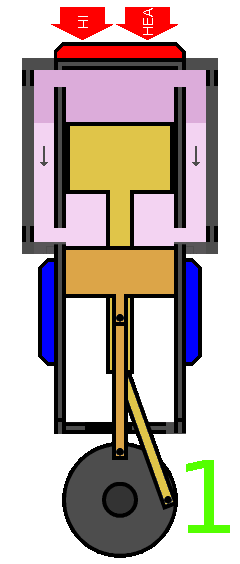STIRLING ENGINE
ME 200 Team 22
What is a Stirling Engine?
A Stirling Engine is defined to be "a machine used to provide power or refrigeration, operating on a closed cycle in which a working fluid is cyclically compressed and expanded at different temperatures." From this definition, it is unclear what sets this concept apart from typical power generation methods like a standard steam turbine. This is what we will explore and more in the following sections.


Pictured above are some basic diagrams of what a simple Stirling Engine/Cycle might look.
To the left is a Pressure vs Volume diagram of the working fluid involved in a Stirling Engine.
In Process 1, a piston expands the fluid isothermally (at constant temperature) to produce power from the fluid.
In Process 2, the fluid is cooled with help from an effective heat sink to absorb heat waste isochorically (at constant volume). Temperature and Pressure both decrease.
In Process 3, the piston compresses the fluid isothermally while doing work (increasing energy) on the fluid.
In Process 4, the fluid is heated isochorically via a heat source which can be of almost any form.
To the right is an example of a simple Stirling engine designed in 1984 by Ivo Kolin.
Why is this Important?
What sets Stirling Engines apart from the other power generation methods? HEAT!
But wait... there's more!
An aspect of this type of heat engine that sets it apart from other heat engines is the presence of a "regenerator"; the component of a cycle used to create an effective temperature differential withing the working fluid. In other words, this helps the engine store heat cycle after cycle so that the engine doesn't have to waste too much energy reaching the proper temperature in the next cycle.
Because this cycle allows for use of almost any heat source, including solar power, the ramifications of this engine in future applications are pretty much endless. It is also has the potential to be much more efficient than the standard steam engine. In a steam engine, often times, heat/energy is inefficiently wasted while moving large distances from the boiler (the component that makes the steam) to the cylinder (where power is generated by the heated steam). In Stirling engines, however, the entire process eliminates the need for a boiler and instead creates a closed regenerative cycle that continually recycles the working fluid.
Types of Stirling Engines
Below are some unique implementations of the Stirling cycle.



<=== Alpha Stirling Engine
- Clearly separated hot and cold parts
Beta Stirling Engine ===>
-Heating and cooling is continuously
done in one cylinder
<=== Gamma Stirling Engine
- One cylinder contains a piston (blue)
while the other contains a displacer (green)
- The displacer is used to move the fluid
between the hot/cold heat exchangers

<=== Low Temperature Difference Stirling Engine
- Considered a gamma configuration with a much
wider displacer
Where to next?
We've defined a Stirling Engine and some of its basic components and operation. Now, it comes time to answer the following: How do we design it and how efficient does it need to be?
This question and more will be answered in our "Preliminary Research" section.
Images and Information sourced from www.stirlingengine.com